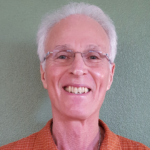 Marty Towbin is a Madrich at Temple Emek Shalom in Ashland, Oregon, where he centers his approach to Mussar through CCM’s concept of semipermeability.
Marty Towbin is a Madrich at Temple Emek Shalom in Ashland, Oregon, where he centers his approach to Mussar through CCM’s concept of semipermeability.
Marty explained semipermeability as a “deep calm presence;” a way of being “simultaneously aware of myself and the other in front of me in a calm, neutral, and receptive stance [where] there is a free flow of soul energy, if you will, between us.” This approach to relationship allows “holiness to pervade the interaction. From a semipermeable state, I’m simultaneously aware of caring for myself while also being available to serve the other before me.”
After retiring from a medical career, Marty said he “found a home in Mussar to be of service, to grow, to learn.” In addition to teaching Mussar classes with Rabbi Joshua Boettiger and Shelia Canal at Temple Emek Shalom in Oregon, he is an active CCM student. “I’m so grateful for the Madrich Colloquium and all the classes being offered. I’m always growing and evolving. I’m feeling more of a part of the CCM family.”
Raised in Conservative Jewish home, after his Bar Mitzvah, Marty drifted away from Judaism: “I was more interested in Baal Shem Tov than discipline, Hebrew lessons, and rules.” He found spiritual connection to God in nature, and drifted between spiritual traditions ranging from Buddhism to Native American practices. Marty studied Transcendental Meditation in the 1970s as a “survival strategy” to get through medical school. It was a Jewish Renewal Rabbi who brought him back to Judaism later in life. By the time he met Rabbi Joshua Boettiger in 2015, he was able to integrate his divergent threads of spiritual practice in a new way.
“Rabbi Joshua introduced me to Mussar, and that allowed me to bring in my own evolving meditation awareness into Jewish meditation. It’s been a nice combination of healing and bringing in my own spiritual experience, grounded in one place.”
Through Mussar, he draws on the Middot [character traits], but doesn’t “lock into them. I find them useful and I appreciate them. But my intention will go to semipermeability before it goes to a Middah.” When he does reach for a Middah, it is often Menuchat haNefesh [Equanimity] because “it resonates with my meditation practice. Equanimity is probably the most central to my person.”
“It was something I felt very aware of in my work as the Medical Director of an Emergency Room. It was my job, by example, not to be over-reactive to things so the other people on our team could stay calm. In the emergency room the key was: how quickly can I center myself? I used to work at an eight bed emergency department, managing up to fifteen patients at a time – a single physician and two nurses for twelve to twenty-four hour shifts. It was really a crucible for learning to keep it together.”
Perhaps that’s where Marty discovered a sense of what he would now describe as semipermeability, a touchstone that he said, “is the witness and the evaluator of what I’m doing on a continuous basis. I’m monitoring myself, monitoring the other, monitoring the situation, monitoring the quality of the interaction. It all funnels through semipermeability.”
Marty teaches semipermeability as the center of Mussar, explaining that, “everything else is learned from that place. What I like to do is introduce and practice semipermeability awareness with students through a meditation and a breath practice that takes one to two minutes at the most. The idea is to get the students used to what it feels like to be semipermeable and then we can talk about it. Then I teach the middot from that place.”
“Meditation and breathwork are wonderful and practical ways of practicing and accessing the experience of semipermeability,” Marty explained. “When we are triggered by a ‘Mussar Moment’ that may catch us in a reactive space, we often stop breathing, and the blood flow in our brain concentrates in our amygdala where our ‘fight, flight, freeze’ response dominates our actions.”
“When we begin to breathe slowly and gently, we re-balance the blood flow to the rest of our brain and can dissipate the reactive feeling we may be experiencing so we can approach the particular situation with the calmness and objectivity of semipermeability, and can hopefully have a free-flowing Neshama-to-Neshama connection with the other individual or situation at hand. Breath work combined with the various Middot and Kibbush/Tikkun protocols we study can help us to more quickly and easily achieve the semipermeable Nefesh state so our Neshama energy flows more easily.”
 Marty Towbin retired from a fulfilling career in medicine in 2015. Through Mussar study and practice, he has found a way to nurture his growing love for Judaism and to live and share its beautiful precepts more fully. He has found Mussar to be an evolving touchstone, offering many gifts for personal and collective growth as we continue to learn to care for each other in our challenging world.
Marty Towbin retired from a fulfilling career in medicine in 2015. Through Mussar study and practice, he has found a way to nurture his growing love for Judaism and to live and share its beautiful precepts more fully. He has found Mussar to be an evolving touchstone, offering many gifts for personal and collective growth as we continue to learn to care for each other in our challenging world.
